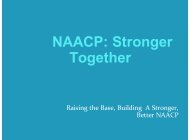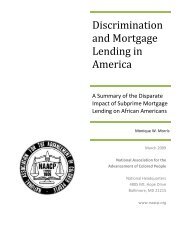TOOLKIT
TOOLKIT
TOOLKIT
Create successful ePaper yourself
Turn your PDF publications into a flip-book with our unique Google optimized e-Paper software.
Project: Climate Action Plan<br />
Communities are resilient and the best way to prepare ourselves<br />
for the impacts of climate change is through planning. In fact, the<br />
social and economic benefits of climate protection are shared<br />
across the community.<br />
Walk:<br />
By researching Climate Action Plans of other similarly sized<br />
campuses or communities, determine a set of goals and strategies<br />
to reach these goals for your Climate Action Plan. For example,<br />
one goal could be to achieve carbon neutrality by 2050 and a<br />
strategy for achieving that goal could be to switch from coal as the<br />
primary source of energy on campus to renewables. When you are<br />
finished with the goals and strategies, you should have a well<br />
developed and multifaceted outline of your Climate Action Plan.<br />
Run:<br />
Set a meeting with the college’s president or a local decision maker<br />
to present your goals for the Climate Action Plan. Ask them to get<br />
on board with your plan to adopt and implement the Climate Action<br />
Plan once it is complete. Without their approval, the Climate Action<br />
Plan will be ineffectual. During the meeting, find out what<br />
strategies and goals are most important and tangible for the<br />
municipality or school.<br />
Sprint:<br />
Create, finalize, and begin to implement the Climate Action Plan. It<br />
is important to engage the community while creating the Climate<br />
Action Plan so constituents are on board with the plan. The<br />
following steps should be taken into account:<br />
1. Engage stakeholders and support collaboration<br />
2. Establish specific clean energy and climate change goals.<br />
3. Consider policies and programs on a variety of topics, such<br />
as Energy Efficiency, Renewable Energy, Land Use,<br />
Transportation, and others.<br />
4. Learn about the successes and challenges of other Climate<br />
Action Plans.<br />
5. Consider feasibility and available resources<br />
6. Monitor and evaluate progress in order to determine results<br />
MILE MARKER 10:<br />
CLIMATE ACTION PLAN<br />
Resources<br />
Sierra Club Cool Cities:<br />
http://coolcities.us/<br />
Clean Air, Cool Planet Toolkit:<br />
www.cleanair-coolplanet.org/toolkit/<br />
Colleges and Universities:<br />
http://rs.acupcc.org/cap/235/?id=235<br />
EPA Climate Action Plan:<br />
http://epa.gov/statelocalclimate/state/stat<br />
e-examples/action-plans.html<br />
Reporting<br />
Remember that different forms of<br />
movement are worth specific steps.<br />
Walk = 50 steps<br />
Run = 100 steps<br />
Sprint = 150 steps<br />
Hydration Stations = 25 steps<br />
In order to receive credit for the 10,000<br />
steps all activities must be documented.<br />
To report projects, click on this<br />
link<br />
Fill out the form titled<br />
REPORTING.<br />
Please make sure all the text<br />
boxes are filled out completely.<br />
It is also recommended that activities are<br />
uploaded to the official NAACP pages<br />
listed below with a brief commentary<br />
which includes:<br />
Name of Youth Council/College<br />
Chapter<br />
<br />
<br />
Location<br />
2-4 sentences describing the<br />
activity.<br />
When using social media, use the<br />
hashtags: #10KSteps, #NAACPECJP or<br />
tag NAACP, NAACPConnect,<br />
NAACPECJP.<br />
53 | P a g e








